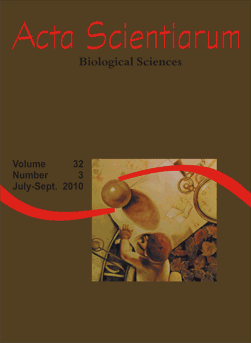<b>Phytoplanktonic composition of three cultivation systems used in <em>Litopenaeus vannamei</em> (BOONE, 1931) marine shrimp farms</b> - doi: 10.4025/actascibiolsci.v32i3.4816
Resumo
The aim of this work is to assess the different compositions of phytoplankton in three cultivation systems of marine shrimps Litopenaeus vannamei (BOONE, 1931), denominated as organic, intensive and semi intensive. The samples were done fortnightly, when phytoplankton was collected by a net for phytoplankton, 65 µm mesh, being then filtrated in a total volume of water of 100 L, and preserved in formaldehyde solution at 4% and identified according to the methodology of Cordeiro et al. (1997). The results show that the densities of Diatoms were of 16.65, 10.47 and 7.57 cel. 103 mL-1 for the organic, intensive and semi intensive cultivations, respectively. As for cyanobacteria, the average figures were 42.06 cel. 103 mL-1 for semi intensive 17.27 cel. 103 mL-1, in the intensive cultivation and 6.11 cel. 103 mL-1 for the organic cultivation system. The dinoflagellates had the highest cellular density in the phytoplankton community analyzed with 61.9 cel. 103 mL-1 in the intensive cultivation, 0.33 and 0.03 cel. 103 mL-1 for both semi intensive and organic cultivation systems respectively. Euglenas presented the results of 4.98 and 14.86 cel. 103 mL-1 only for semi intensive and intensive cultivations. It was then concluded that all cultivations presented average rates below recommended for such studied systems.Downloads
DECLARAÇÃO DE ORIGINALIDADE E DIREITOS AUTORAIS
Declaro que o presente artigo é original, não tendo sido submetido à publicação em qualquer outro periódico nacional ou internacional, quer seja em parte ou em sua totalidade.
Os direitos autorais pertencem exclusivamente aos autores. Os direitos de licenciamento utilizados pelo periódico é a licença Creative Commons Attribution 4.0 (CC BY 4.0): são permitidos o compartilhamento (cópia e distribuição do material em qualqer meio ou formato) e adaptação (remix, transformação e criação de material a partir do conteúdo assim licenciado para quaisquer fins, inclusive comerciais.
Recomenda-se a leitura desse link para maiores informações sobre o tema: fornecimento de créditos e referências de forma correta, entre outros detalhes cruciais para uso adequado do material licenciado.












1.png)




3.png)













